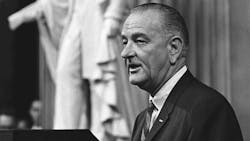OP-ED: Happy 58th birthday, Federal Transit Administration
Many remember late President Lyndon Johnson for succeeding President John F. Kennedy after his assassination in Dallas, Texas, on Nov. 22, 1963. Others remember him for his domestic Great Society Program - this included Civil Rights, Medicare, Medicaid, the War on Poverty, Public Broadcasting - and as a friend of Israel. There was also other foreign policy, most notably the Vietnam War. Few remember his other landmark legislation. This was the foundation for federal financial support of public transportation.
This July marks the 58th anniversary of federal government support for public transportation. The success of public transportation can be traced back to one of President Johnson's greatest accomplishments that continues benefiting many Americans today: on July 9, 1964, he signed the "Urban Mass Transportation Act of 1964" into law. Subsequently, this has resulted in the investment of several hundred billion dollars into public transportation. Funding was provided under grants from the Urban Mass Transportation Administration, which in 1991, became the Federal Transit Administration (FTA).
In the current federal fiscal year 2022, the FTA has made available a record $20 billion in funding under various formula and competitive discretionary programs to more than 900 transit agencies around the nation. Four of these formula programs include:
- $6,408,288,249 Section 5307 Urban Formula (plus $348,290,112 Section 5340 High Density States & $280,465,968 Section 5340 Growing States);
- $4,111,504,865 Section 5337 State of Good Repair ($3,994,326,976 High Intensity Fixed Guideway & $117,117,889 High Intensity Motorbus);
- $601,222,535 Section 5339 Bus and Bus Facilities; and
- $36,500,000 Section 5307 Passenger Ferry.
One way these dollars can be used, depending upon the program, is to pay for replacement of aged buses, paratransit or commuter vans, light rail, subway, commuter rail or ferries that have reached their minimum useful life according to federal replacement eligibility criteria. They are also available for fleet expansion.
A number of national competitive discretionary programs also exist to supplement transit agencies formula programs. Some examples are:
- $3,848,000,000 Section 5309 Capital Investment (New Starts & Core Capacity);
- $1,174,998,689 Section 5339(c) Low or No Emission;
- $546,029,313 Section 5339 Buses and Bus Facilities;
- $300,000,000 Section 5337 State of Good Repair Rail Replacement; and
- $49,000,000 Section 71102 Electric or Low Emitting Ferry.
If you haven't already done so, apply for funding under the FTA Transit Award Management System (TrAMS). This is used by FTA to award and manage federal grants. There is still time at this late date to enter your grant(s) in TrAMS. Try to complete your grant application and answer any questions from FTA Regional Office staff as quickly as possible. This will afford FTA the opportunity to give you the green light in TrAMS, so you may formally submit your grant.
Official submission of any grant in TrAMS on or before Friday, July 29, 2022, would increase your odds for success in obtaining any approved grant before the end of federal fiscal year 2022. This would also provide the hard working FTA Regional Office staff 39 business days before Friday, Sept. 23. Remember they have families or partners, and would like to take some time off during the summer for well deserved vacations.
TrAMS usually shuts down one week before the end of September, which this year, might be Sept. 23, for final obligation of pending grants. Closing down of TrAMS for grant obligations provides FTA HQ time to balance the financial books. This is necessary in preparation for reports to Congress and Office of Management and Budget on current federal fiscal year expenditures.
In our post COVID-19 world, millions of Americans are continuing the journey back to utilize various public transportation alternatives. These include local and express bus, paratransit and commuter van, ferry, jitney, light rail, subway and commuter rail services. All of these systems use less fuel and move far more people than conventional single occupancy vehicles. Most of these systems are funded with your tax dollars thanks to President Johnson.
Depending upon where you live, consider the public transportation alternative. Try riding a local or express bus, paratransit or commuter van, ferry, light rail, commuter rail or subway. Employers offer transit checks to help subsidize a portion of the costs. Utilize your investments and reap the benefits. You'll be supporting a cleaner environment and be less stressed upon arrival.
The ability to travel from home to workplace, school, shopping, entertainment, medical, library etc., is a factor when moving to a new neighborhood. Economically successful communities are not 100 percent dependent on automobiles as the sole means of mobility. Seniors, students, low and middle income people need these transportation alternatives. Investment in public transportation today contributes to economic growth, employment and a stronger economy. Dollar for dollar, it is one of the best investments we can make.
What better way to honor President Johnson and all that has been achieved these past 58 years in public transportation by continuing to fully fund the federal Highway Trust Fund and Mass Transit Account.
Happy Birthday!
------------------------
Larry Penner is a transportation advocate, historian and writer who previously worked for the Federal Transit Administration Region 2 New York Office. This included the development, review, approval and oversight for billions in capital projects and programs for the MTA, NYC Transit, Long Island Rail Road, Metro North Rail Road MTA Bus, New Jersey Transit along with 30 other transit agencies in NY & NJ.
About the Author

Larry Penner
Larry Penner is a transportation advocate, historian and writer who previously served as a former director for the Federal Transit Administration Region 2 New York Office of Operations and Program Management. This included the development, review, approval and oversight for billions in capital projects and programs for New Jersey Transit, New York Metropolitan Transportation Authority, NYC Transit bus, subway and Staten Island Railway, Long Island and Metro North railroads, MTA Bus, NYCDOT Staten Island Ferry along with 30 other transit agencies in New York and New Jersey.
